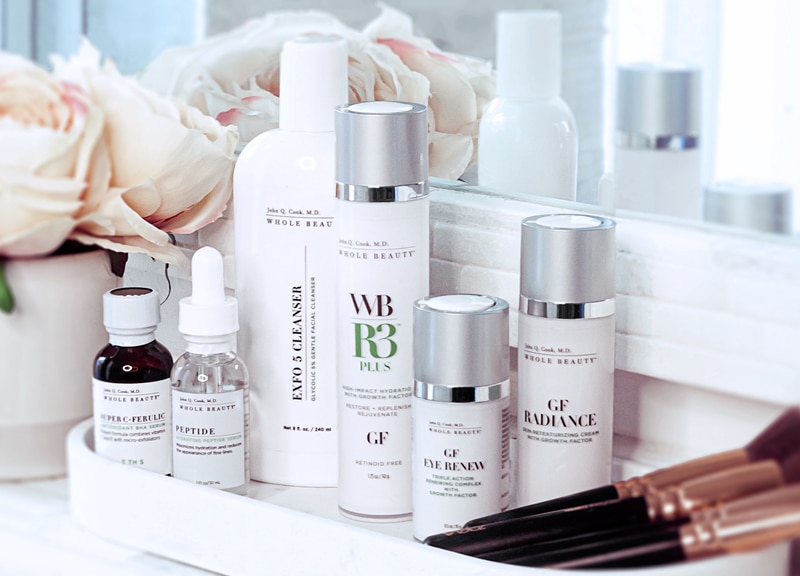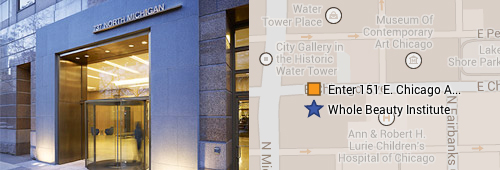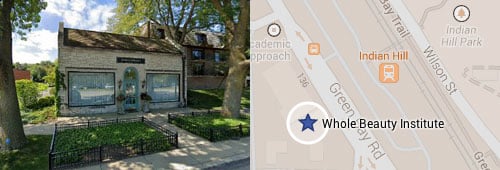Why Dr. John Q. Cook Is the Right Facial Plastic Surgeon for You
Dr. Cook has extensive experience having performed several thousand facelift procedures in his career and has combined fat transfer with structural lifting for over 25 years.
Dr. Cook’s technique to facelift surgery addresses the four dimensions of facial rejuvenation: structure, volume, expression, and surface.
Dr. Cook’s surgical approach allows most patients to have a facelift under local anesthesia. He has lectured at national and international meetings about this technique.
Dr. Cook’s surgical philosophy is rooted in naturalism: facelift surgery should make you look more like you, rather than like someone else.
Education and Credentials

Awards and Recognition

REAL PATIENT RESULTS
See the difference experience makes. Scroll through before and afters in the photo carousel of facelift patients treated by Dr. Cook and his team.
Rejuvenate and Refresh Your Face in Chicago and Winnetka
Patients who are considering a facelift from the Chicago area’s Dr. John Q. Cook typically feel that their face no longer accurately represents their “true self.” Instead, over time, it has begun to send a message counter to their inner sense of well-being.
Ready to achieve a younger-looking appearance and match your outside look to your internal vitality? Positive change is possible with a facelift!
While it’s true that every face tells a story, some patients may want their own face to tell one of vigor and youth instead of age. Dr. Cook provides a wide range of options for patients seeking a facelift at his Chicago and Winnetka offices. At Whole Beauty® Institute, each facelift procedure is customized to address the patient’s individual needs, blending decades of experience with the latest in technology and techniques. Facelift surgery has come a long way and is more advanced than ever before — and facial rejuvenation surgery has been Dr. Cook’s passion for his entire professional career. His devotion to individualized, naturalistic facelift results has won him recognition in the Chicago area, nationally, and internationally.
Facelift Video Gallery: Watch Dr. John Q. Cook’s videos that cover various topics about facelift surgery.
“The planning of each facelift operation must take into account the nuances of each face.” —John Q. Cook, M.D.
What Is a Facelift?
What does a facelift involve? What happens during a facelift?
A person’s overall face shape can gradually change as they get older. Collagen and elastin loss occurs due to age, so the skin becomes thinner and doesn’t snap back into place as easily over time. Sagging eventually develops around the eyes, along with the lower jawline and neck. The cheeks also begin to thin and flatten when volume is lost. Deep folds of skin may form on the lower face.
In general, the clean dynamic lines of the face lose their clarity and definition and the beautiful curves of the face flatten as facial structures settle. Corners of the mouth turn downward, and the outer brow droops, making you appear tired, sad, or angry. Aging faces lose the fat that previously provided youthful volume, leading to sagging skin, jowls, and hollowness.
All of these changes can be treated with a facelift. Also known as a rhytidectomy, a facelift is a facial rejuvenation procedure that involves lifting portions of the face while also excising redundant sagging skin. In addition to treating this laxity, muscles and fat are also repositioned.
The goal is to refresh and rejuvenate the face by restoring youthful definition and contours. A facelift will give the face a younger-looking shape and a less tired appearance. The procedure may also involve smoothing deep skin folds on the middle and lower areas of the face.
This surgery is often combined with a neck lift to address fat and sagging skin on the neck area, giving the whole region a sleeker appearance.
Who Is an Ideal Candidate for a Facelift?
How do I decide if I need a facelift? Who is a good candidate for a facelift?
If you are unsure as to whether this cosmetic surgery would be a good fit for you, here’s what you should know about what makes you eligible for a facelift: This surgery is a highly individualized treatment. In most cases, patients would be considered good candidates if they are in good health, do not have any underlying medical conditions that could delay healing, are non-smokers, and maintain a positive outlook and realistic expectations.
The procedure is ideal for individuals who have developed signs of aging—such as some sagging on the face and neck—but who still have some skin elasticity. It’s common for patients in their 40s to 70s to have a facelift, but even older patients may sometimes be candidates. There has been increased interest in facelift surgery among younger patients as well.
Patients who naturally have a strong, distinctive bone structure will usually achieve the best results from a facelift.
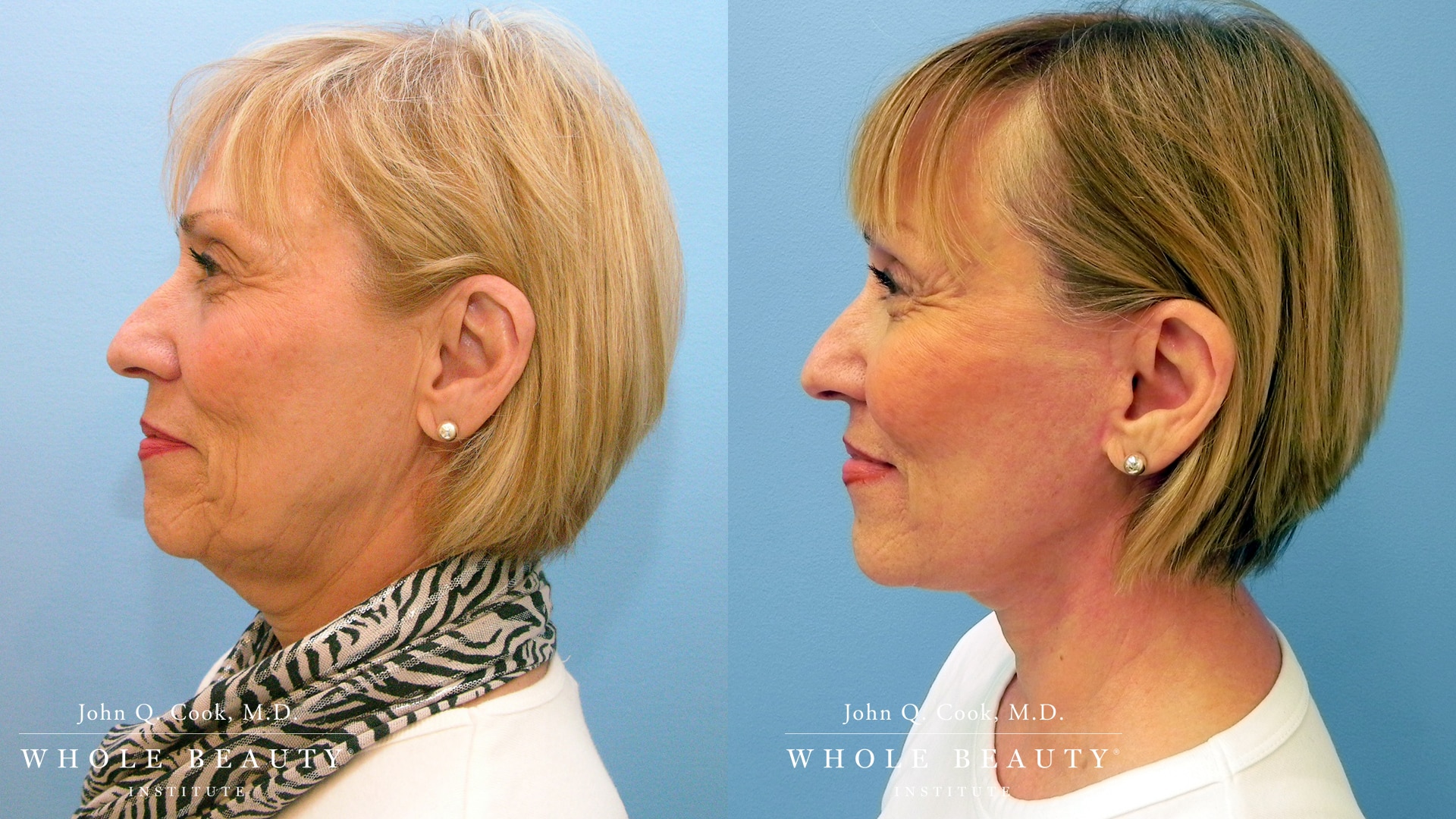
Which Type of Facelift Is Best?
Many patients aren’t sure which technique will be best for them. Dr. Cook will help you decide which approach is most suitable and put together a personalized plan.
Dr. Cook tailors each patient’s surgery accordingly based on their needs. At your initial consultation, he will examine your facial anatomy and determine the severity of your facial aging. He will also take your goals and medical history into account. Each patient will have final say, of course, and everyone is encouraged to ask questions and learn about their options.

There is no single facelift solution — and non-surgical solutions can only go so far
An individualized approach to each patient requires individualized solutions. One of the reasons that I find facelifts and other facial rejuvenation surgeries so captivating is that you never stop learning from your patients. The only practical limitation is one’s own perception and imagination. The face is so nuanced, you could spend a lifetime studying it and really just be at the beginning. All of the subtleties of facial contour, motion, and tone demand the surgeon’s respect.
I am helping my facial rejuvenation surgery patients the most when I have a repertoire of facelift techniques. This repertoire has grown with each passing year.
Unfortunately, we live in an era of hyper-aggressive marketing. Some surgeons insult their patients’ intelligence by placing undue emphasis on one aspect of facelift surgery technique and implying that this will be the final solution to facial rejuvenation. For example, some facelift surgeons prattle on about short scar facelifts or s-lifts, as if these are remarkable innovations. In fact, variations of these facelift operations were described in the 1920s and before. As we have already seen, skin removal is often the least important element of a facelift, so to place the entire emphasis on where incisions are made really takes the focus away from what is truly important.
The first thing that anyone who is serious about a facelift will tell you is that each patient needs an incision that is appropriate for him or her. For some patients, the facelift scar will be quite short; for others, the facelift scar will be longer. This does not lend itself to catchy phrases for marketing a facelift, but it is the truth. Remember, too, that a short facelift scar produced by an unskilled surgeon is usually much more noticeable than a longer facelift scar produced by an experienced and talented one.
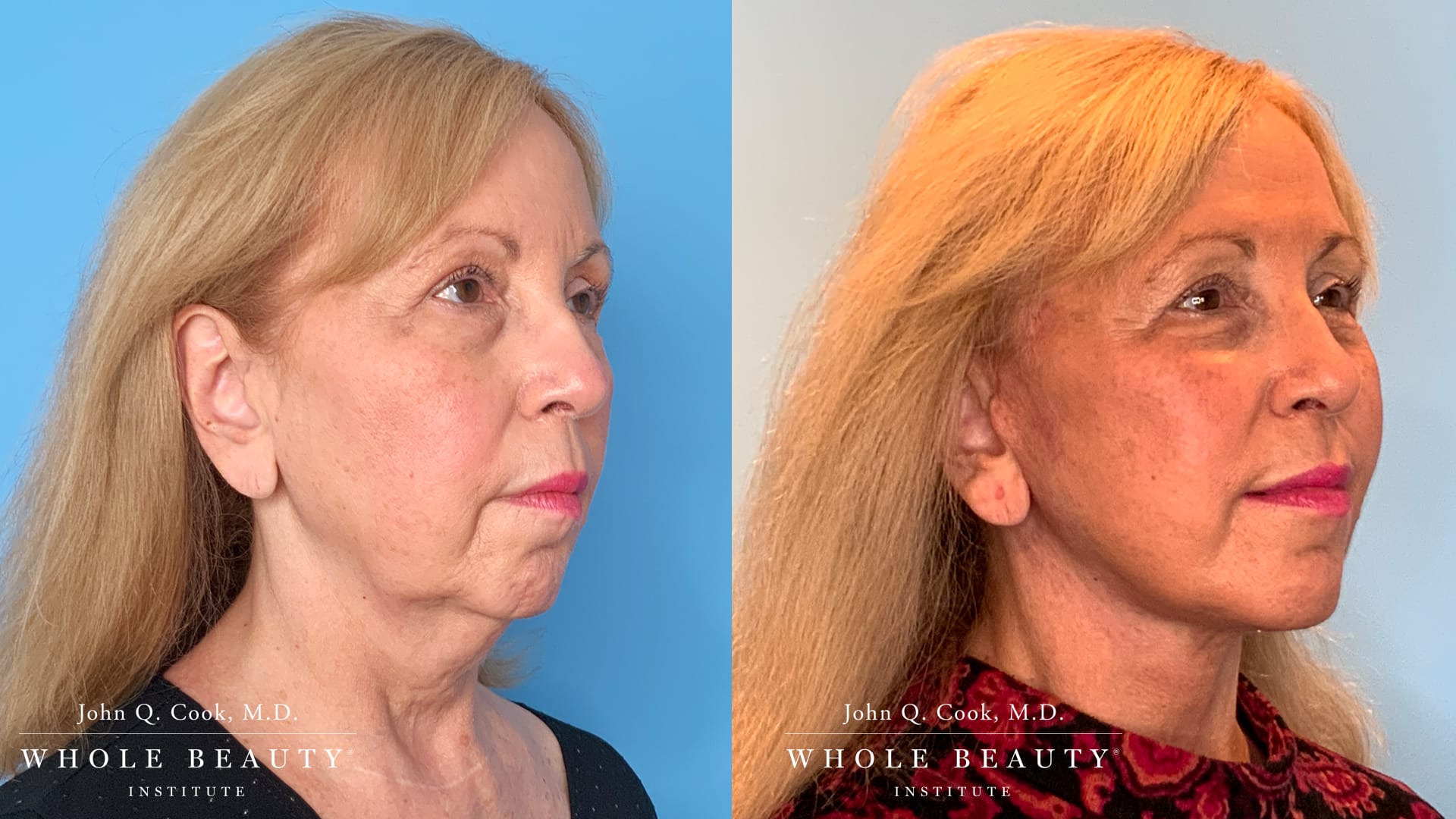
Facial rejuvenation surgery is about much more than tightening the skin. It is about restoring facial structures and volume to the position of dynamic harmony.
As a face ages, it may present subtle miscues to those who observe it. Facelift patients often tell me during their initial consultation that even their best friends and spouses misperceive their attitudes and emotions. People ask them, “Are you feeling tired?” or “Why are you so angry with me?” when they are not feeling that way at all.
When we look at a face, our eyes naturally scan specific regions that are rich in information, so that we can determine that individual’s state of mind. These regions include the corners of the mouth and the zones around the eyes. People who are particularly good scanners of this type of facial information are often said to be gifted at reading other people’s emotions.
As facial structures drop and facial regions lose their curves and volume, the resting attitude of the face may assume a sad or angry posture. The dynamics of facial expression are also altered. It may become more difficult for the face to convey subtle nuances of emotion, and certain expressions may require greater effort than before.
It is my firm belief that when a facelift is properly performed, it moves the face closer to its unique signature or identity. This facelift results may also produce a beneficial feedback mechanism in the people who perceive that face.
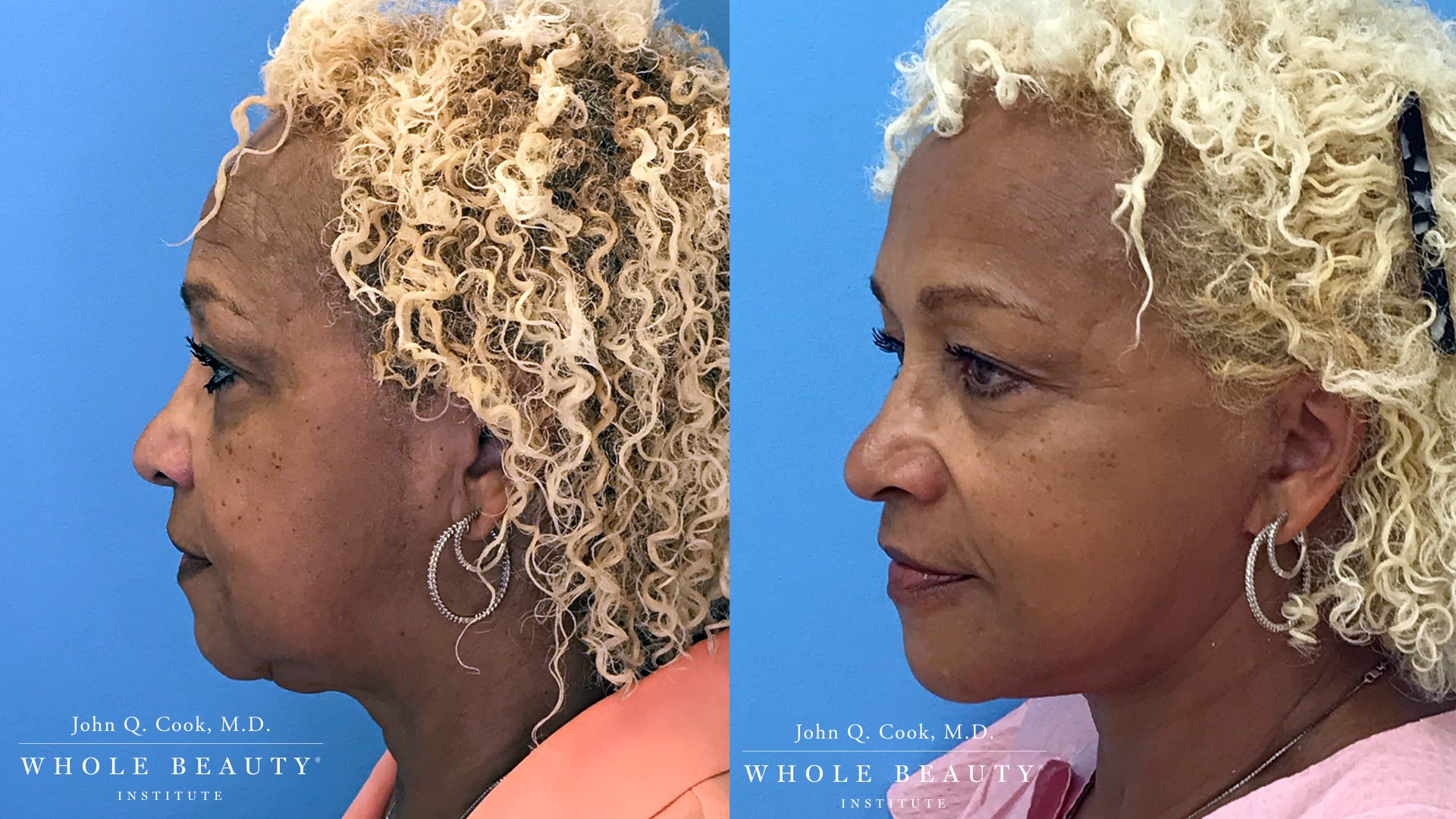
What Are the Different Types of Facelifts?
Full Facelift and Neck Lift
When there is significant loss of tone in the major zones of the cheek, jaw border, and neck, the best solution is typically a full facelift and neck lift. Dr. Cook’s facelift technique emphasizes a vertical correction of the deeper structures and a rebalancing of the facial volume to correct the hollowness that often occurs in key regions, such as the upper cheek and the supporting zones around the lips.
The key with this facelift method is to avoid the distortion that so often occurs with facelifting techniques that tend to pull aggressively out to the side. The length of the facelift incisions in front of and in back of the ear will vary with each patient’s unique anatomy. Dr. Cook respects the complexity of the ear and hairline, so his facelift techniques are designed to minimize distortion of these structures.
Temporal Facelift
In select facelift patients, the key zone of concern is a settled upper cheek, which creates a look of hollowness in the area immediately beneath the lower eyelid. There may also be a mild to moderate loss of definition along the mid-cheek, but continued good definition in the neck.
For a patient with these specific changes, a temporal facelift is often a good choice. Dr. Cook gains access to the necessary tissues through incisions that follow the curve of the upper ear and sideburn or are hidden along the temporal hairline. The power of this facelift technique is enhanced when it is combined with volume rebalancing of the upper cheek with the fat transfer technique.
Facial Volume Rebalancing with Autologous Fat Transfer
For many patients, the loss of deep structural volume due to the natural atrophy of fat in key zones of the face leads to an overall hollow or gaunt appearance that cannot be corrected by lifting alone. Dr. Cook frequently combines facial fat transfer with his varied facelift and neck lift techniques in order to obtain the most natural-looking results. Fat transfer is also a wonderful “booster” technique that can restore balance to the face several years after a facelift has been performed. This can often be accomplished via a simple procedure in the office under local anesthesia.
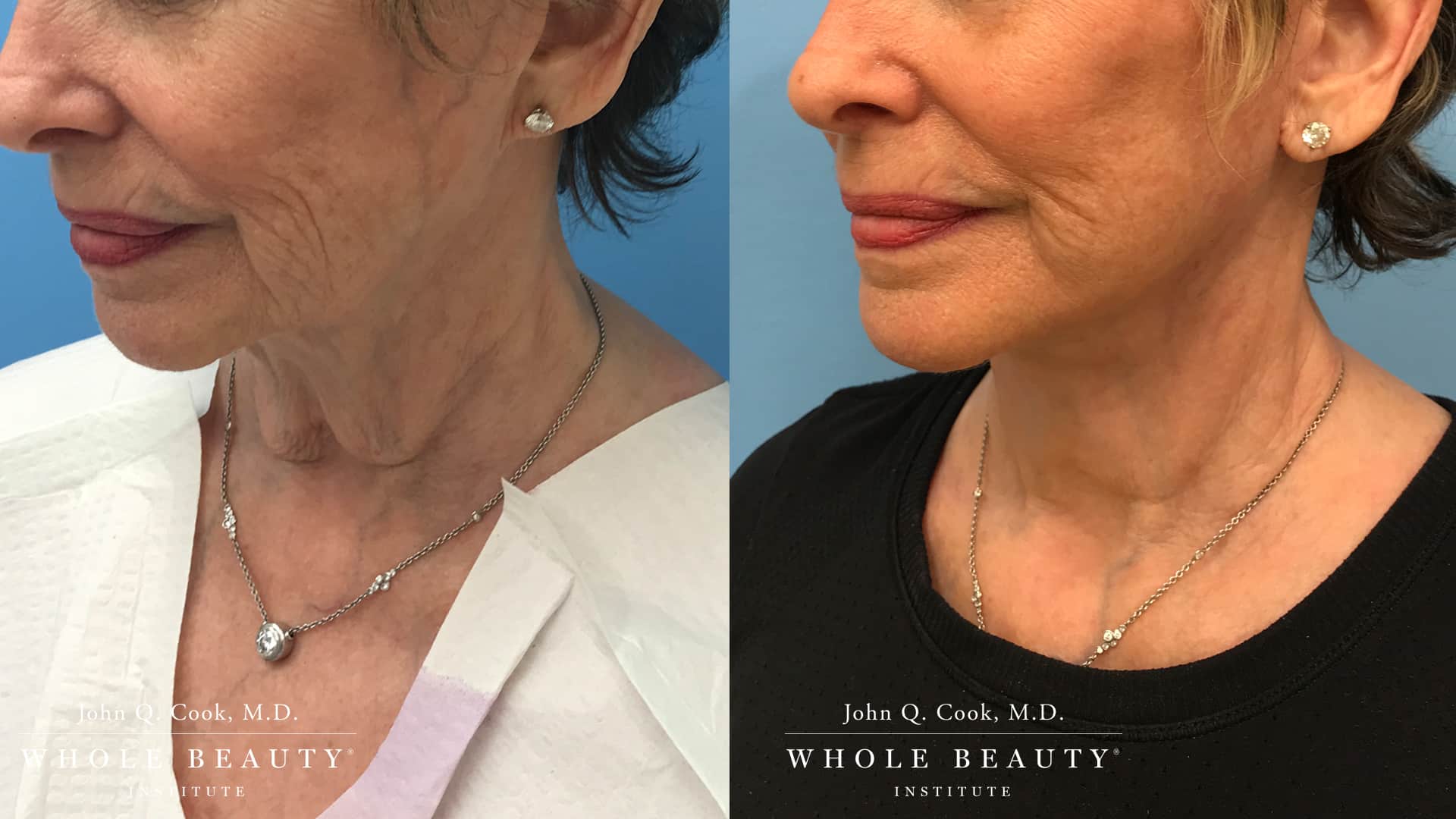
Optimum facelift results occur when a top-tier surgeon works with a team that is totally committed to patient care.
The quality of your facial rejuvenation surgery experience is strongly influenced by the quality of the team that your surgeon has assembled to care for you before, during, and after your facelift or other procedure. During your initial consultation, you will have the opportunity to meet a number of these facial rejuvenation surgery team members. How they relate to you tells you much about the “soul” of the organization for which they work. Look for people who provide you with a sense of confidence, compassion, and service. Avoid organizations that emanate a sense of the “hard sell.”
The Three Distinct Phases of Facelift Surgery
The facelift surgery experience has three distinct phases: the preparation phase, the surgical phase, and the healing phase. A well-functioning team will extend your facelift surgeon’s ability to optimize your care during each of these phases.
The Preparation Phase of Facelift Surgery
The preparation phase begins with a detailed assessment of your overall state of health, nutrition, and fitness. Patients who are fit and optimally nourished recover more quickly from facelifts than those who are not. We have found that the period leading up to facial rejuvenation surgery can be an invaluable “inflection point” for our patients. The habits that we encourage in preparation for facelift surgery can stay with you after the surgery and provide as much benefit to you as the facial rejuvenation surgery itself!
During the preparation phase, we will also provide suggestions to optimize the quality of the skin prior to the facelift itself. We believe that by rejuvenating the skin structure, we can enhance the longevity of the surgical results.
A great team is able to anticipate your needs and enhances your passage through the facelift experience in ways that pertain to a particular procedure, but which also relate to your distinct needs. The simple, practical suggestions that they provide make the difference between a smooth recovery and one that can be frustrating. Look for a team of individuals who are responsive and anticipatory during the preparation phase; these are the same individuals you will need to count on during your facelift recovery.
The Surgical Phase of Facelift Surgery
The surgical phase involves the operation itself. It is the shortest and most intense phase of your facelift experience. If you have followed my suggestions, you will have selected a leading surgeon to carry out the operation effectively and with artistic inspiration. I know leading surgeons who operate in their own offices, in surgicenters, and in hospitals. Regardless of the setting, a truly leading surgeon will not allow for compromise in the quality of care.
Many of our patients are delighted to learn that we can carry out their surgery under local anesthesia in the office. In addition to the simplicity and safety that is inherent in local anesthesia, there is the comfort of working directly with my hand-picked team.
If you prefer general or IV sedation anesthesia, the team at the surgicenter consists of recovery nurses, operating room nurses, surgical technicians, anesthesiologists, and anesthetists.
The Healing Phase of Facelift Surgery
The facelift healing phase is significantly influenced by the quality of the team that cares for you. Many of our patients spend the first night after surgery in a five-star hotel in the same building as the surgicenter and two blocks from our Chicago office. A team member can provide care that evening at the hotel or in your home if you are near where your surgery was performed. If you spend the first night at the hotel, our clinical team can visit you the next morning in the comfort of the hotel room. Our goal is to provide you with a seamless continuity of care. In the early weeks after a facelift or other facial rejuvenation surgery, you will have frequent contact with the clinical team. It is essential that every member of the team is imbued with the spirit of service and compassion.
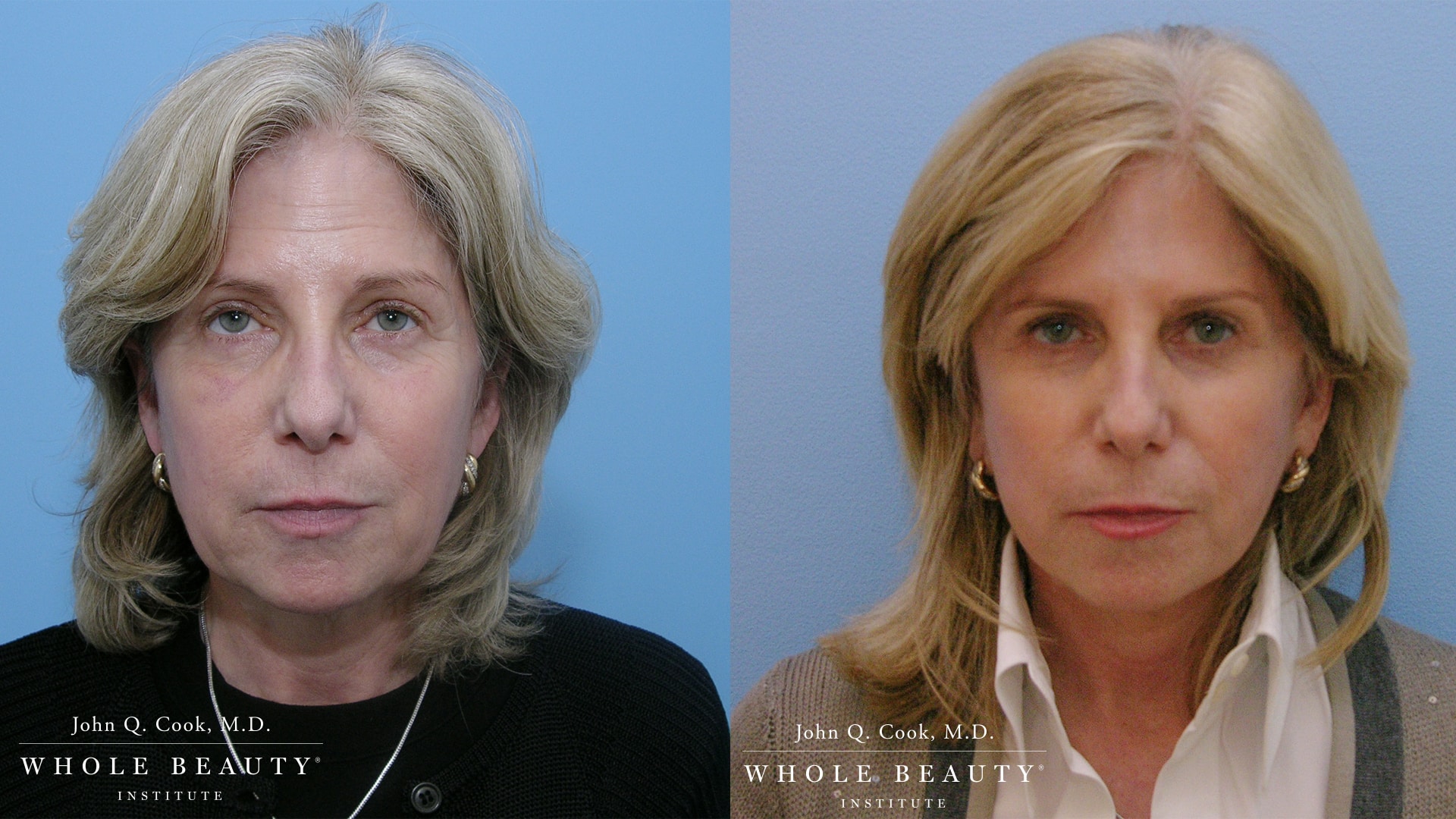
What Is Dr. Cook’s Approach to Facelift Surgery?
Do facelifts ever look natural? Is a facelift customizable? The reason why Dr. Cook takes a customized approach to facelift surgery is because each face ages differently. For some people, aging will mainly impact one area of their face or neck—such as the jawline—which will be their primary area of focus.
For others, all areas may be affected almost equally. Dr. Cook knows that patients want to look like a more youthful version of themselves while still maintaining their natural features. Each facelift procedure is tailored to address specific goals on a unique face and achieve the most harmonious, balanced, and natural results possible.
In this video, Dr. Cook explains the 4 Dimensions of a Facelift: Tone, Volume, Expression, and Surface, and why it is so important to take these dimensions into account when consulting a patient and preparing for face lift surgery. why it is so important to take these dimensions into account when consulting a patient and preparing for face lift surgery.
Can a Facelift Be Customized for Your Specific Needs and Goals?
For facelift surgery, we believe in taking a personalized approach and assessing each patient on a case-by-case basis. Before selecting a facelift technique, Dr. Cook will spend a great deal of time analyzing the individual character of your face, along with your desired results, medical history, and lifestyle. He will analyze your face in natural light, since this provides the best understanding of your face’s contour and structure. During your initial facelift consultation, he will pay attention to your signature patterns of facial expression and how they may have been altered by the facial aging process. Part of his facelift analysis also involves a study of your face over the years. For this reason, he will ask you to provide photos of your face from different times in your life. Dr. Cook will also explore your history of exercise, weight fluctuation, and sun exposure, all of which can affect the results of facelift and other surgery.
He will review any fillers, relaxants, or other medical-grade skin treatments you have received, since these may have a bearing on an accurate analysis, as well as your treatment plan. We aim to get an in-depth understanding of each patient. Along with exploring your medical background, we are also interested in your patterns of activity such as work, social obligations, family responsibilities, and travel. These may affect our recommendations for the timing of your facelift surgery and recovery.
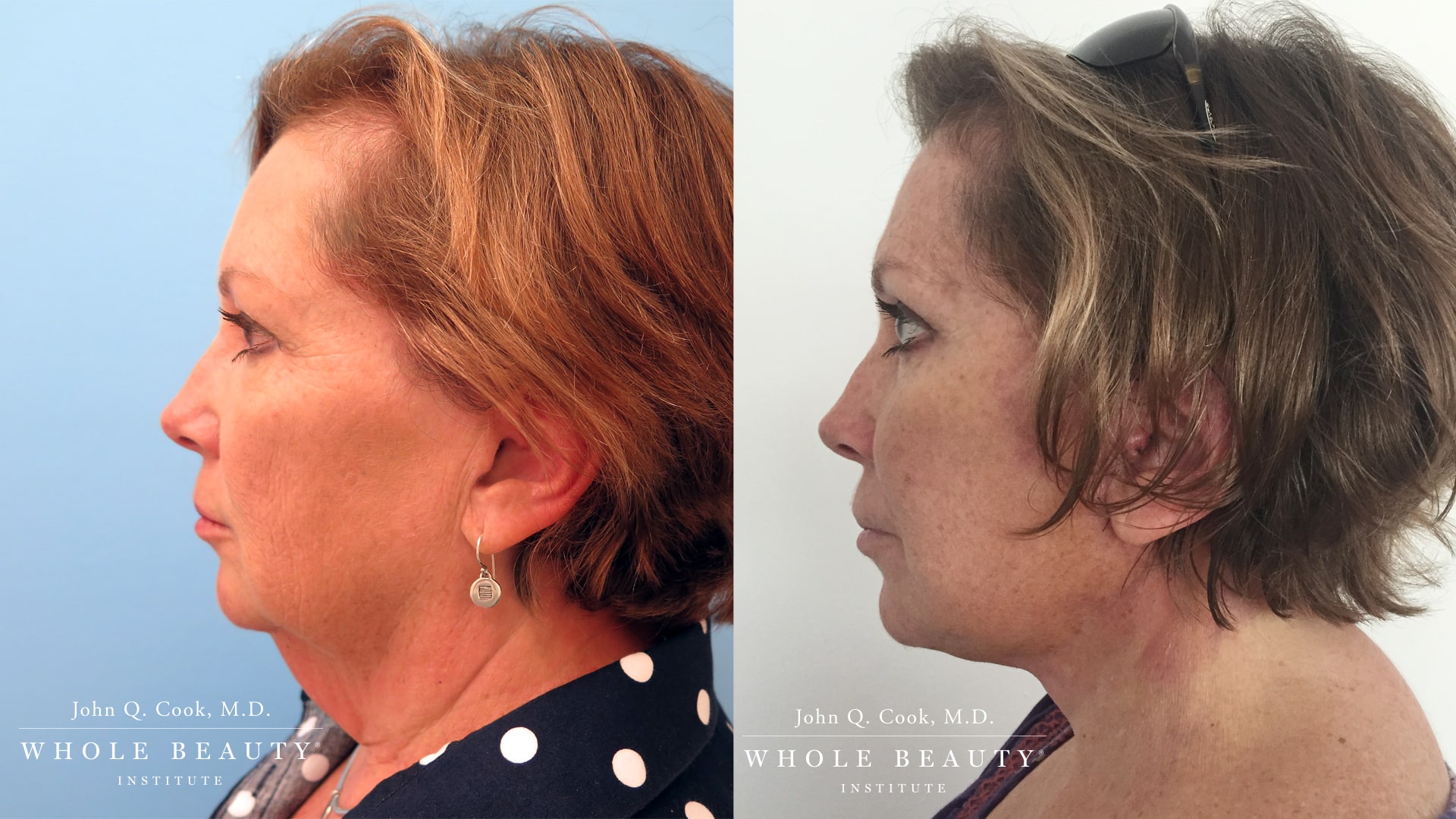

The Benefits of “Keeping It Local”: Most Facelifts Don’t Require General Anesthesia
When it comes to facial rejuvenation, Dr. John Q. Cook is clear about what works best: facelift surgery. As a Chicago-based plastic surgeon, Dr. Cook sees the benefit of wrinkle relaxers, fillers, and “tightening gadgets,” as he calls them, but none of these minimally...

The Art and Science of Facelifts
Age might bring wisdom, but it also brings visible signs of aging: wrinkles, sagging skin, and loss of muscle tone. For many of us, these visible changes can lead to a feeling of disconnect between our appearance and our youthful spirits. That’s where the facelift...
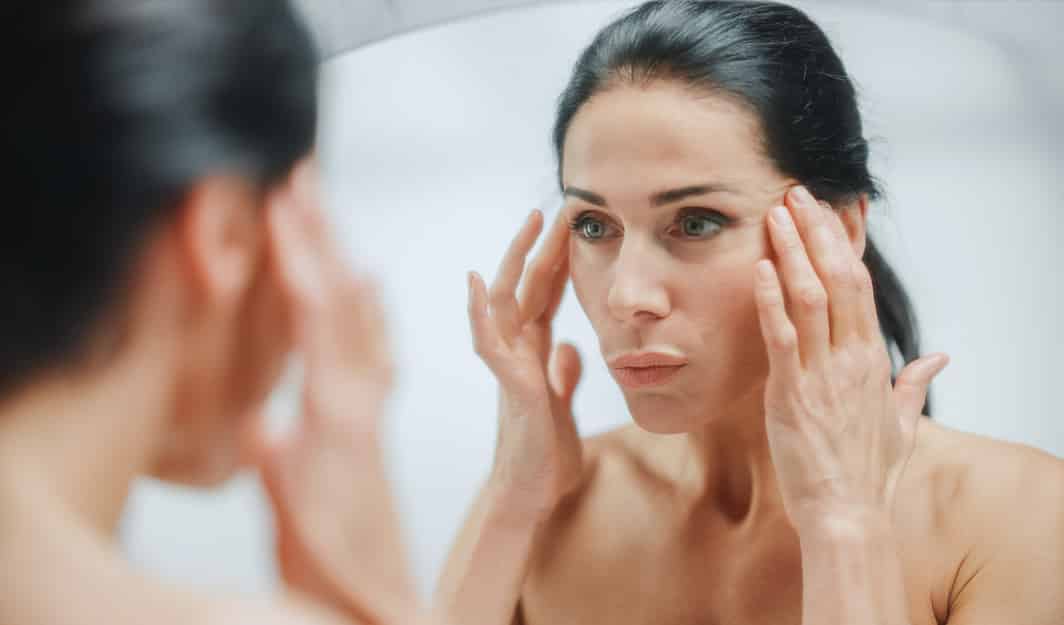
Facelifts – 10 Things You Should Know
Wondering what you should know before a facelift? My Chicago-based team supports patients knowing as much as they can about this treatment in order to help them have the best experience possible and achieve optimal results. As a board-certified plastic surgeon, these...
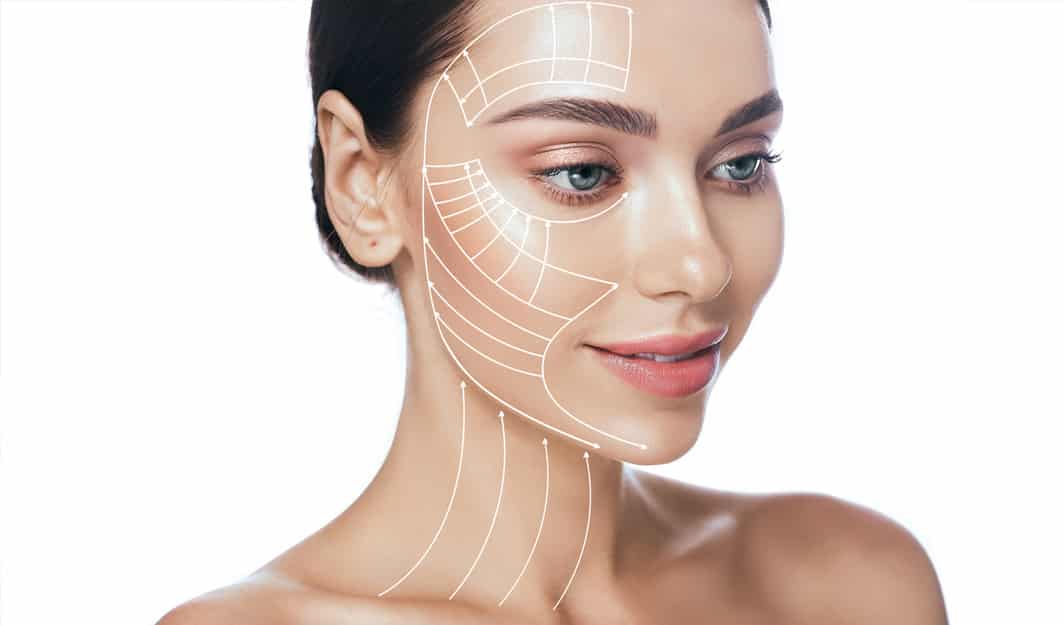
Understanding the Different Types of Facelifts
Sagging skin and a loss of fat volume in the face causes a person’s overall face shape to change as we age. Thinning cheeks, sagging jowls and, in some cases, drooping eyelids can make you look tired and unhappy—even if you don’t feel that way. Facial plastic surgery...

Facelift Recovery – What You Need to Know
Dr. Cook discuss the phases of facelift recovery, what to do prior in preparation for your surgery, and common questions patients ask regarding the recovery and results from facelift surgery.

Can You Have a Facelift with Just Local Anesthesia?
Sagging skin on the face is linked to a loss of facial volume or fat, along with damage or loss of the collagen and elastin fibers that provide support for the skin. As we age, it’s common to develop a gaunt or sunken appearance in the cheeks and temples, while skin...
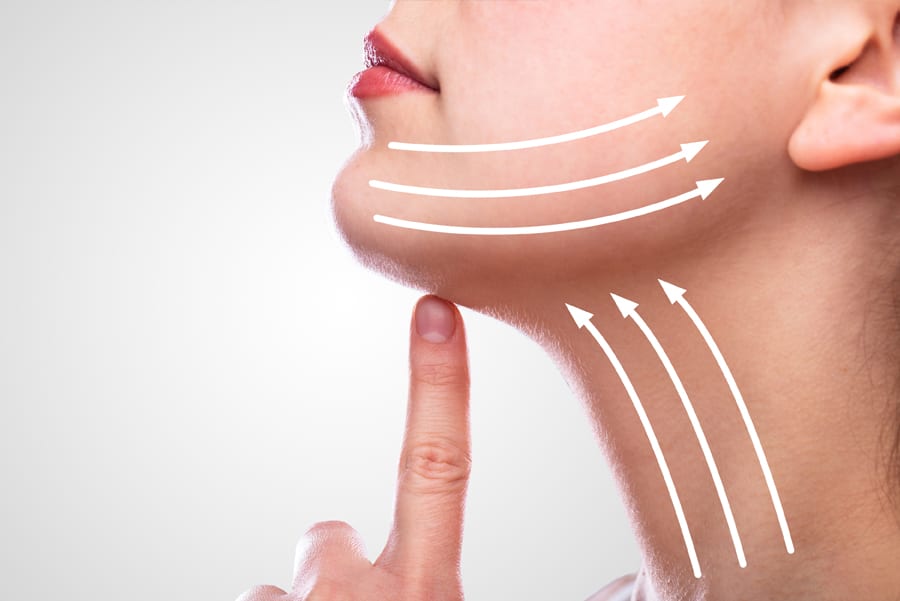
Lifting the Lower Face
Surgical and Minimally Invasive Options for Lifting the Lower FaceWhile the term “facelift” sounds to many people like it involves everything from chin to forehead, facelift surgery at the Chicago area’s Whole Beauty® Institute is based upon a precise analysis of the...

FaceTite or Facelift: Which is Better For You?
Time, gravity, and the aging process are our faces’ worst enemies. As we age, the facial skin and tissues lose their tone and begin to sag. We also often lose the fat that provides a beautiful soft contour to the face. If your face has fallen prey to these changes,...

Face Lift: Who Benefits the Most?
10 Predictors of Face Lift Success If you are considering a face lift or other forms of facial rejuvenation surgery the cooler months during fall, winter, and early spring are an ideal time in Chicago. The hours of sunlight are shorter and there are less outdoor...

7 Predictors of a Successful Face Lift
You can improve the chance of having an excellent result from face lift surgery that will last many years if you take an active role in preparing for your surgery. These seven measures have distinct benefits for long term health and well-being. Many of my patients have used face lift surgery as a catalyst to bring about positive changes in their lives.
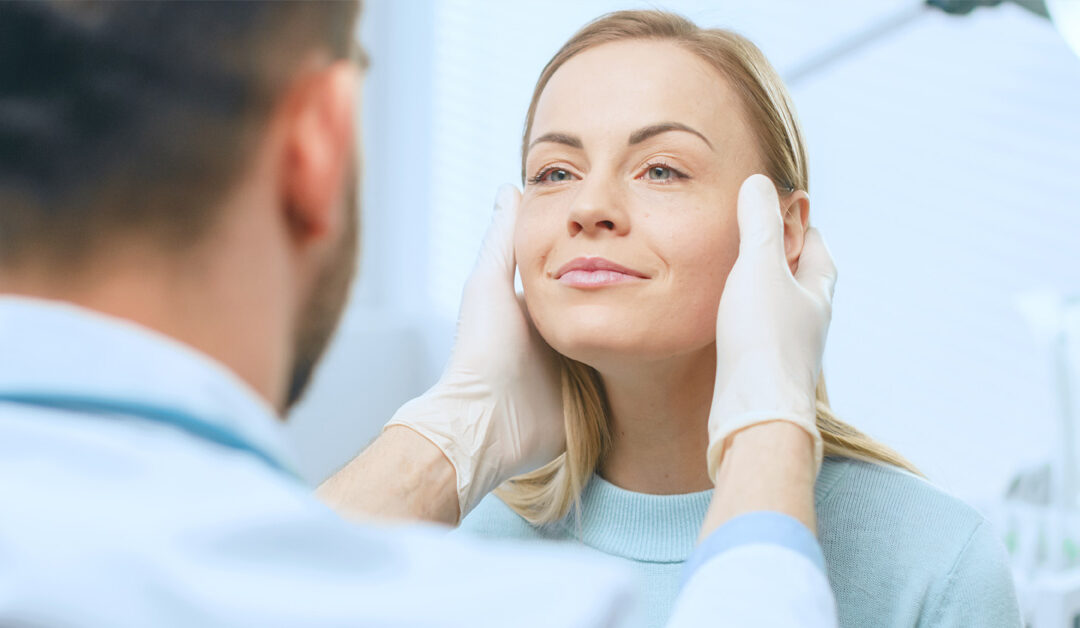
10 Ways to Prepare For Facial Rejuvenation Surgery
Facial rejuvenation surgery is a major focus of the practice of Dr. John Q. Cook. We have recommendations that will help our patients recover from face lift, neck lift, jaw border lift, brow lift, and eyelid surgery. Our goal is to have you as pleased with the recovery process as you are with the results of surgery.

Facial Rejuvenation Under Local Anesthesia
Many patients who consider facial rejuvenation surgery forego the procedures because they do not want to experience general anesthesia. Over the past few years we have worked to develop techniques of facial rejuvenation surgery that allow us to rejuvenate all of the major facial zones under local anesthesia.

Volume Is Key to a Natural Face Lift
When patients come to see me for a facelift consultation one of their biggest concerns is that the result will somehow appear unnatural or over-pulled. I tell these patients that I am equally concerned with these issues. Unnatural facelifts tend to stand out in a...
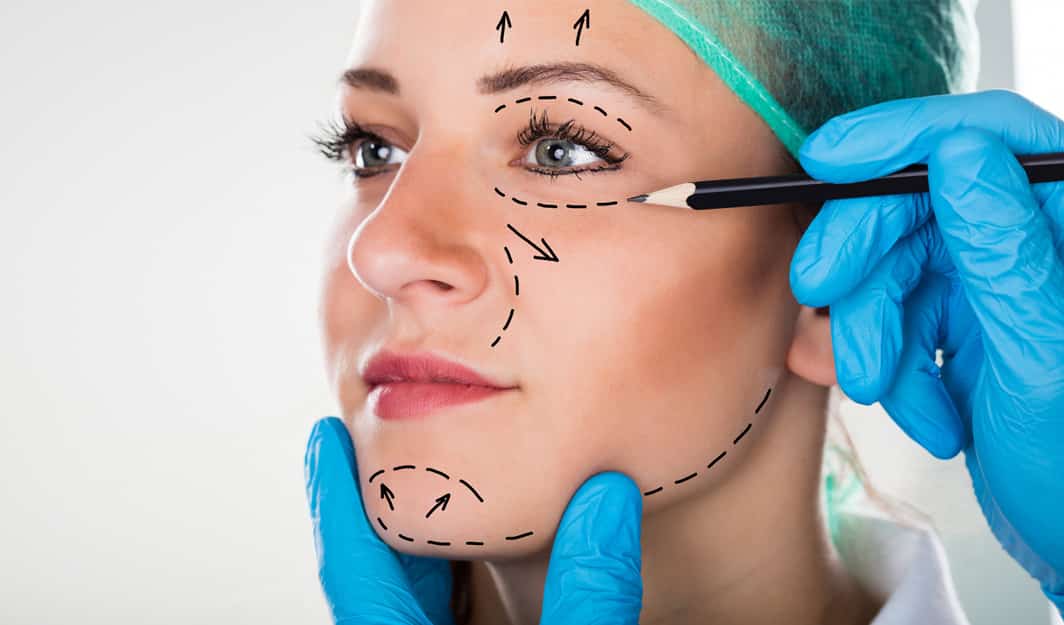
There Are Many Different Face Lifts
In plastic surgery, as in the rest of medicine, optimum treatment proceeds from an accurate diagnosis. To accurately diagnose facial aging the surgeon needs to look at the three key regions of the face: the upper cheek (some call it the midface), the jaw border, and the neck. In each of these areas there may be problems of tone, which improve with lifting procedures, or volume, which improve with the addition or removal of fat.

Advantages of Local Anesthesia for Facial Rejuvenation
An increasing percentage of our patients choose from our portfolio of limited incision surgeries for facial rejuvenation. These surgeries include customized face lifts, cheek lifts, jaw border lifts, and neck lifts, as well as certain types of brow lifts and eyelid surgery. They can be carried out under local anesthesia in the comfort and privacy of the Whole Beauty® Institute in Chicago and Winnetka.
Debunking Common Myths or Misconceptions About Facelift Surgery
Facelift surgery can reverse the signs of aging, restoring your face to a more youthful, natural version of itself. While a facelift is the gold standard for restoring a youthful appearance, there are several common reasons why patients are hesitant to pursue facelift surgery:
Fear of an Unnatural Facelift Result
You may have seen pictures of celebrities who have undergone facial surgery that has left them looking altered in weird ways. Dr. Cook adheres to principles that lead to beautiful, natural results. We have an extensive collection of before-and-after pictures in our offices displaying examples of Dr. Cook’s work. In fact, many of our new patients are referred by patients on whom he has already performed facelift surgery, and they have already seen firsthand how natural facelift results are when artistic principles are respected.
Fear of Facelift Scars
A common concern is that the incisions used during facelift surgery will be noticeable and draw attention after surgery. Dr. Cook takes extra care to ensure that any potential scars are discreetly hidden. His decades of experience and careful attention to detail enable him to place incisions in a manner that they follow the natural curves and shadows around the ear. As a result, the incisions blend in as they heal.
Fear of "Going Under" for Facelift
Fear of Facelift Recovery
For most patients, there is very little pain associated with the recovery after facelift surgery. Ice and Tylenol are often all that is needed. We have a team of experienced nurses available to spend the first night with you at a nearby luxury hotel to get your recovery off to an excellent start. For patients who travel far, we can arrange for longer stays. In the days that follow a facelift surgery, we see our patients frequently, leaving no small detail to chance. Read more about facelift recovery.

Contact Whole Beauty® Institute to arrange a consultation for a facelift in Chicago or Winnetka. Call 312-751-2112 or send a message online.
Request a consultFacts You Need to Know About Facelift Surgery
Facelift surgery is a nuanced fusion of technique and artistic expression.
The skills and sensibilities that are necessary to produce consistent high-quality results in facelift surgery require years of refinement. Surgeons who shortcut this process do themselves and their facelift patients a disservice.
There is a remarkable beauty and complexity to the organization of the facial structures. The surgeon should approach these structures with a respect that borders on reverence. It is naive to think that the nuanced facelift techniques necessary to address these structures can be easily mastered. There is no endpoint in the process of technical refinement. I believe that the surgeon learns something useful from each person that he cares for. Every patient on whom he has performed a facelift in the past contributes to the quality of the outcome of the current patient.
Technique alone is sufficient for many kinds of surgery, but it is only the first step in facelift surgery. The amplifier of technique is artistic vision. I am now going to say something that is a bit controversial: As I look at articles in leading plastic surgery journals, I am often struck by how horrible the “after” pictures of facelift patients appear! The faces look different, but they don’t look better, and they certainly don’t look younger. The facelift surgeons who have written these articles often have impressive academic credentials and are technically proficient. They haven’t harmed the faces in the way that a poorly trained or disrespectful surgeon might, but the fact that they present these facial rejuvenation surgery pictures as examples of their facelift work makes me wonder about their artistic side.
Artistic sensibility is inherent, but can also be refined and strengthened with exercise. Just as advanced practitioners of meditation techniques extend their perceptions, so can any artist who is involved in the creative process. For each generation, the artistic vocabulary changes, but the fundamental truth does not. For plastic surgeons offering facelift surgery, the first level of artistic visualization comes when the facelift surgeon has internalized a vision of beautiful facial form. The second, more difficult level comes when he begins to understand the internal logic of each face and how it demands its own unique facelift solution.
Facelift surgery requires an advanced understanding of the dynamics of facial aging and a highly individualized approach to each patient.
Many of the less successful outcomes of facelift surgery derive from a fundamental failure of diagnosis. This facelift surgery should not be about pulling the cheek skin back toward the ears and emptying out the fat from around the eyes. The drawn, sunken look that results from this type of facelift and eyelid surgery cannot remotely be considered young or vital. Then there are the various gadgets and threads that are supposed to tighten the skin. This represents a conceptual step backward to a 1960s concept of facial rejuvenation surgery and facelifting as a skinpulling or -tightening procedure.
When we age, the deeper structures of the cheek and neck descend in paths that are generally predictable, but with specific variations for each face. An effective facelift should reverse this structural descent. The goal of a facelift should be to restore key curves of beauty and definition to their original position. A face that has been restored in this manner will not look strange or different to the friends of the patient, because they have already seen that face before.
An accurate diagnosis of facial aging must also include considerations of volume. If bone structure provides a face with its defining foundation, and skin provides its surface, then fat provides its attractive soft curves. In retrospect, it is hard to understand why, for so many decades, surgeons offering facelift surgery focused exclusively on removing fat from the face rather than enhancing it. All the while, there were the Katherine Hepburns of the world, who were noted to age remarkably well. Just look Katherine’s cheeks when she was in her 60s and even her 70s!
One of my patients who is now a convert to fat volume restoration suggested that part of the problem is that the word “fat” carries negative connotations for so many of us. We do become increasingly efficient at storing fat in certain problem zones of the body as we age. Those of us who have devoted countless hours at the gym to reduce undesirable bulges across the waist or hips have a hard time believing that we would want to add fat anywhere.
For many facial rejuvenation surgery patients, a loss of fullness in key zones such as the upper cheek, the jaw border, and the supporting regions of the lips precedes significant structural descent or loss of skin tone. The best answer for these patients is often volume replacement and nothing more.
I hope that this discussion makes it obvious why assembly-line facelifts are certain to be a failure. There is no “one size fits all” facelift. The surgeon who is serious in his approach to facial rejuvenation surgery must consider the interplay between three key variables: skin tone, deep structural descent, and volume loss. For each patient and in different zones of the same patient’s face, the relative importance of these variables will be different.
A facelift should never produce a mask.
The process that allows us to recognize a face is complex. I believe that there are both static and dynamic components to facial identity. Facelift surgery and nonsurgical treatments can alter these components for better and for worse.
What is a bad facelift or bad BOTOX®? We can find plenty of examples if we turn on the television or go to a charity benefit party in a big city. There is something awry in the posture and motion of these faces. Sometimes the effect of a bad facelift can be quite disturbing.
On the other hand, a face that has been skillfully rejuvenated will call out to others in a different way. A properly rejuvenated face will look more vital, softer, healthier, and more expressive. It should not look manipulated. The first thought that will occur to a friend is that you look rested and full of energy.
Let me better explain for you what I mean by static and dynamic facial identity, so that you will understand why it is important to consider them in any form of facelift or other facial rejuvenation surgery. Static facial identity is the equilibrium position of the face, or the resting posture that the face assumes when we are not in a process of active expression. You might say that this is the posture the face assumes during a moment of pleasant relaxation. It is also the posture of the face when one engages in various relaxation techniques or in meditation.
As we have already seen, the aging process frequently alters the position of static facial identity, so that it may not appear “rested” or relaxed to the outside observer. This may create an undesirable feedback loop between a person and those she interacts with. If the resting position of the face conveys the impression of fatigue or anger, then the response of the outside world may cause that person to move the face out of its position of relaxation. It is my opinion that this maladaptive response can have undesirable consequences and lead to a person feeling less relaxed.
Dynamic facial identity comes from signature patterns of facial motions. Some of the motions may be compensatory. As we age and our facial structures descend, it is natural for us to animate in ways that bring our brows, our cheeks, and our lips into the positions that they once occupied. There is a paradox, in that what once occurred with maximum relaxation now requires an effort.
The core of dynamic facial identity is not compensatory. It is learned from our parents and those who are key to us when we are little. It is developed to a degree by imitation as we begin to copy those whom we admire during our adolescence and teenage years. It is really a complex layering of experience that orchestrates the motion of facial identity.
The importance of the dynamic facial signature is demonstrated by an experience that is universal. An individual walks toward us in a crowded airport. Deep in her own thoughts, she has not made eye contact with us. Is this our friend whom we have not seen for several years or someone who looks like her? We call the friend’s name, and as her face animates there is either a flash of recognition or an embarrassment. The moment that the face animates, we know for certain whether it is or is not our friend. We could not describe precisely what has happened, but we have searched for our friend’s signature of dynamic facial motion.
These observations have relevance to any patient considering a facelift, other facial rejuvenation surgery, or non-surgical options. The surgeon who chooses to do this facial rejuvenation work carries a responsibility. He does not have the right to be oblivious to issues of facial motion and posture. Rather than using a facelift to create a mask that obscures our facial identity, he should use a facelift to amplify and restore that identity.
In the overall analysis of facelift and other facial surgery, volume is as important as structure.
chemical peelsDuring their consultations, patients considering a facelift often tell me that they feel that their faces have become increasingly harsh in appearance as they age. It is as if something that gave the face a wonderful softness has been diminished. What these potential facelift patients have perceived quite accurately is that their faces are losing volume in key zones of beauty. This has the effect of throwing the face out of balance.
One of the first zones in which facelift patients notice change is the upper cheek. Just look back at your high school or college yearbook. Look at the wonderful curves of the upper cheeks, even in relatively thin faces!
Even in their 30s, many people begin to lose the unbroken curves of their upper cheeks. What was once a smooth curve becomes visually fragmented and hollow. As the upper cheek loses its fullness, the structures of the lower eyelid are unmasked. If a facial plastic surgeon does not appreciate these issues, he may compound the problem by performing an overly aggressive lower blepharoplasty. If too much of the natural lower eyelid fat is removed, the lower eyelid structures are reduced to the level of the sunken upper cheek. This gives the entire region a flat, hollowed-out look that simply cannot be considered rejuvenation. In fact, the area is made less youthful in appearance by such injudicious maneuvers.
One of the paradoxes of facial rejuvenation surgery for the cheek-eyelid junction is that the addition of fat to the upper cheek reduces the need to remove fat from the lower eyelid. In the vast majority of the lower eyelid surgeries that I perform, I will do something to add volume to the upper cheek. It helps to restore the “magic” to this key expressive area and allows me to avoid the creation of a hollow eye.
The supporting zone around the lips and along the jaw border is also subject to volume loss, usually a little later than the upper cheek. If this area is not addressed as part of an overall strategy of facelift and facial rejuvenation surgery, the lips will look strangely out of balance when the cheek is lifted. Just as with the cheek-eyelid junction, many doctors really have focused on the wrong thing for decades when it comes to the lips. All that they could see were the creases and lip lines. This led to extremely harsh methods of treatment: very deep dermabrasions, laser treatments, and chemical peels. In order to have much of an effect, the treatment has to go so deep that the pigment structure of the skin is permanently altered. I have seen many a “laser cripple” who can never leave home without a thick layer of makeup, to avoid detection of her “white moustache” of de-pigmented skin.
A better facial rejuvenation answer for most people with lip volume loss is a combination of therapies. Deep volume loss is addressed with fat transfer, while issues closer to the surface are addressed with Restylane®, Juvederm®, and other fillers. These hyaluronic fillers are formed from a simple sugar molecule that naturally provides volume and resiliency to the deeper layers of the skin and tends to deplete with the aging process. Gentler surface treatments can then be done to soften the remaining creases and wrinkles.
Of course, the facial rejuvenation techniques that we use to restore volume to zones of the face can produce ridiculous results if the hand that does the injection is not linked to a mind that has judgment and experience and an eye with a good artistic sense. I am absolutely baffled by some of the lips that have been created for certain people in the entertainment industry. Lips are not supposed to look like cocktail sausages!
Facelift and facial rejuvenation surgery can help to maintain the balance between a dynamic body and a vital face.
At a health club where I work out, I recently overheard a conversation between two women who were observing a friend as she ran around the track. “Mary is working out a little too much. Her face is starting to look terrible.” This snippet of conversation points to a mean little paradox of healthy aging. Beyond a certain age, those of us who keep our bodies trim and fit tend to look gaunt and hollow in the face. The very energy that we put into maintaining optimum fitness seems to rob our face of its vitality.
Facelift and facial rejuvenation surgery really comes to the rescue in a situation like this in that it frees us from the necessity of choosing between a beautiful body and a vital facial appearance. When volume and balance are restored in a face, harmony returns between face and body.
In this sense, I believe that facial rejuvenation surgery can be an integral part of an overall plan for health and well being. For many people, a facelift or other facial rejuvenation surgery removes a stumbling block on the road to fitness. No longer does a person need to say, “When my clothes fit right, my face looks tired.”
When a facelift brings a face into harmony with one’s inner sense of vitality, a positive feedback cycle occurs that further encourages healthy habits. This simple truth is the reason that I have maintained for many years that facial rejuvenation surgery, when artfully performed, can be part of a holistic approach to healthy living.
Due diligence is an absolute necessity when you evaluate a plastic surgeon—especially for facelift surgery.
Medical marketing has exploded in the last decade, and this is particularly true in the field of cosmetic surgery and facial rejuvenation. There are good and bad points to this. On the one hand, patients may be better aware of their range of facelifts and other choices than they were in the past. It is easier to obtain relatively detailed information about various doctors on the Internet, so that one can look beyond the immediate neighborhood when choosing a physician for a facelift or other facial rejuvenation.
On the other hand, the facelift doctor whose services you are buying may turn out to be very different than what he seems unless you really know what to look for. Modern marketing techniques can easily distract the patient away from meaningful credentials to meaningless ones. One of the most valuable services I can provide is education to help the individual who is considering a facelift—or other plastic surgery options—to distinguish between meaningful and meaningless credentials.
What Is Facelift Recovery Like?
Patients frequently ask, “How long does it take to look ‘normal’ after a facelift?” If you are curious about what to expect and how to speed up facelift recovery, this is what you should know: Patients will usually experience some minor side effects such as mild to moderate pain, drainage from incisions, swelling, bruising, and numbness. Bandages applied after the surgery provide gentle pressure to reduce swelling and bruising. It’s recommended that patients keep their head elevated when resting, take pain medication as instructed, and apply cool packs to provide some relief for discomfort and swelling.
What Does a Facelift Cost?
Every facelift procedure is highly individualized, and costs may vary greatly based on the patient’s unique goals and needs. After your consultation, you will be provided with a quote. Whole Beauty® Institute does offer facelift payment options through Care Credit.
How Does Facelift Surgery Compare with Non-Surgical Cosmetic Treatments?
Patients who have tried to counteract signs of aging with fillers or neurotoxins may find that these treatments work well at first, but eventually may no longer be as effective as they age. When these techniques are used improperly or overused, they may create an ultimately unnatural look.
A facelift provides more dramatic rejuvenation in a way that would not be possible with injectables alone. Facelift surgery is the best option for more dramatic and severe signs of aging, such as sagging skin.
Dr. Cook has many years of experience in facial rejuvenation and strives to achieve the most dynamic, expressive, and natural-looking results, no matter the degree of facial aging.
Our entire facelift team places a great emphasis on an in-depth understanding of each patient. This includes a careful exploration of your medical history, your current state of health, and your well-being, as these impact directly the safety of your facelift surgery and the ease of your recovery.
We are also interested in your patterns of activity such as work, social obligations, family responsibilities, and travel. These may affect our recommendations for the timing of your facelift surgery and recovery.
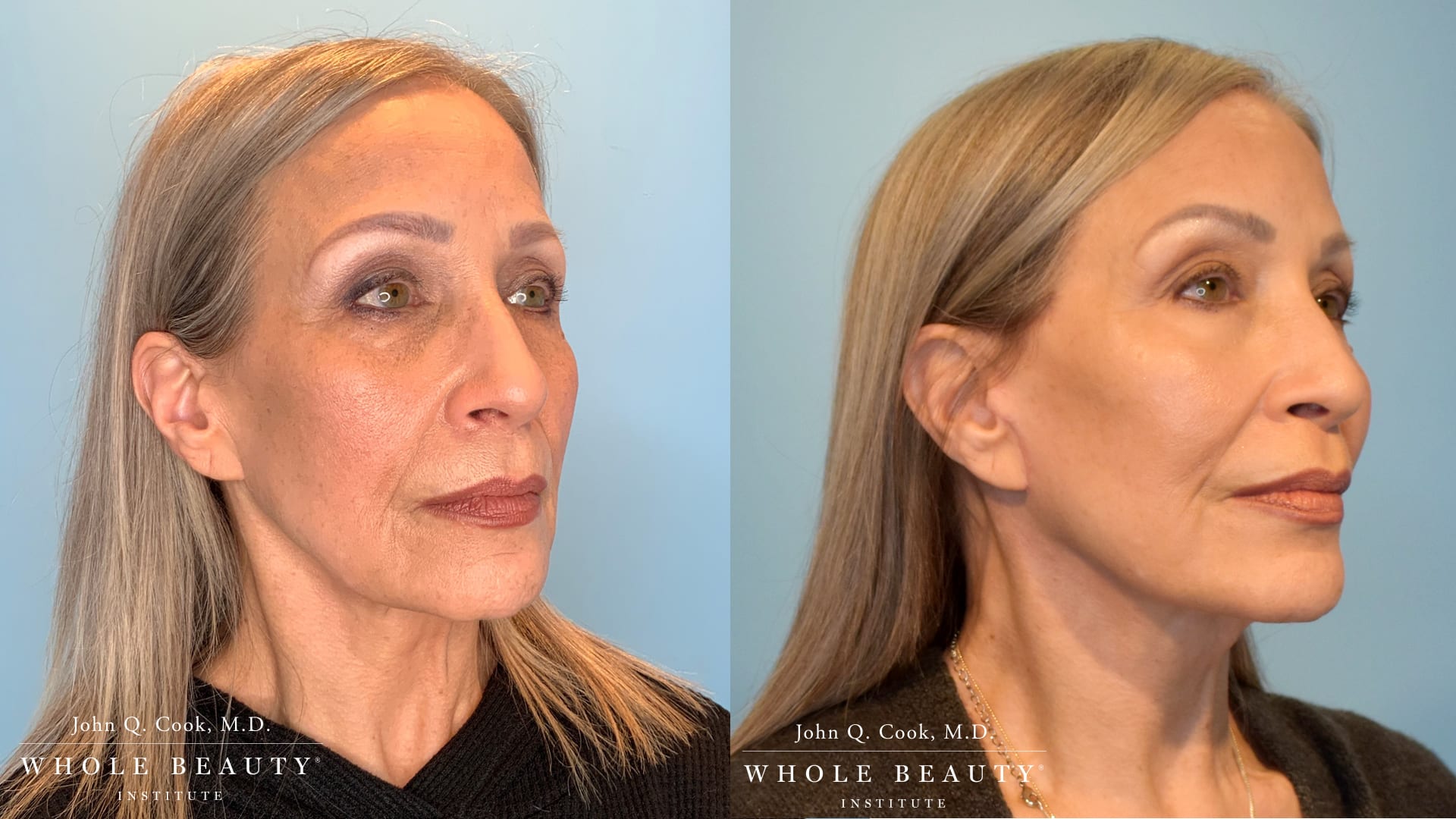
The non-surgical facelift does not exist
I feel fortunate to practice in an unprecedented era of expanding possibilities for my facial rejuvenation patients. We now have available a wide range of non-surgical options to soften and mitigate facial appearance: everything from BOTOX®, which selectively relaxes frown muscles, to an expanding array of fillers, to various therapies to improve the tone and texture of the skin. I use these wonderful tools every day in my practice. They fit in well with my emphasis on facial rejuvenation, particularly for patients with early facial aging or for those with more advanced changes, but who don’t want a facelift and are willing to settle for a more limited result. I also use the adjunct techniques to fine tune and embellish my surgical facelift results as part of a program of total facial rejuvenation.
It disturbs me when certain practitioners imply that these adjunctive techniques can be combined in a way that will obtain results similar to those of a facelift. Those who make this assertion lack honesty—or, at the very least, insight. Why is it that when I go to meetings in the United States and Europe and sit through hours of presentations, I never see results from these “non-surgical” approaches that obtain a fraction of the power of a skillfully performed facelift or other facial rejuvenation surgery? Unfortunately, some doctors so believe their own marketing that they will give presentations where they sing the praises of their own work while the audience can’t tell the difference between the “before” and the “after” pictures.
More Facelift Resources
Dr. Cook has assembled a thorough catalog of educational resources for patients who want more in-depth information about facelift and other facial surgery options.
Which Cosmetic Procedures Are Available to Complement a Facelift?
One of the most common misconceptions about this surgery is that it will involve the entire face. Facelift surgery is actually primarily focused on the lower two-thirds of the face. It involves enhancing the cheeks and the middle to lower regions of the face.
To rejuvenate the area around the eyes and forehead, a completely different set of techniques will be needed, since the tissues in these areas are different from the other parts of the face. To improve your overall facial rejuvenation results, you may wish to combine a facelift or neck lift technique with eyelid surgery (blepharoplasty) and surgery for the brow region (brow lift). We will explain these options during your consultation.
While a facelift can lift and tighten certain areas of the face, remember that this procedure won’t address sun damage or improve the appearance or quality of the skin itself.
Beyond a facelift, non-surgical treatments that improve the tone, texture, smoothness, and quality of the skin can also be beneficial in their own way. Neuromodulators such as BOTOX®, Dysport®, and Xeomin® relax facial muscles that cause dynamic wrinkles. Juvederm®, Restylane®, and other injectable facial fillers add temporary volume to reduce static wrinkles that are associated with the loss of volume and elasticity.
Laser skin resurfacing and chemical peels promote collagen production for more even, vibrant, and healthy skin while addressing concerns such as uneven pigmentation, dullness, dryness, wrinkles, scars, and other blemishes.

Contact Whole Beauty® Institute to arrange a consultation for a facelift in Chicago or Winnetka. Call 312-751-2112 or send a message online.
Request a consultDr. Cook's Practice Blog
Explore our practice blog to learn more about non-surgical treatments and plastic surgery procedures available at The Whole Beauty® Institute. Get tips and advice, and discover new ways to improve your health and beauty.
Dr. Cook's HealthGems Blog
Dr. John Q. Cook shares his personal thoughts on well-being, quality of life, and more in HealthGems—from his decades of experience in the industry, studying and working with advanced technology and techniques.
Whole Beauty Skincare
SkinShopMD.com was created by Board-Certified plastic surgeon, Dr. John Q. Cook, as a trusted source for high quality, medical-grade skincare products to protect and rejuvenate your skin.
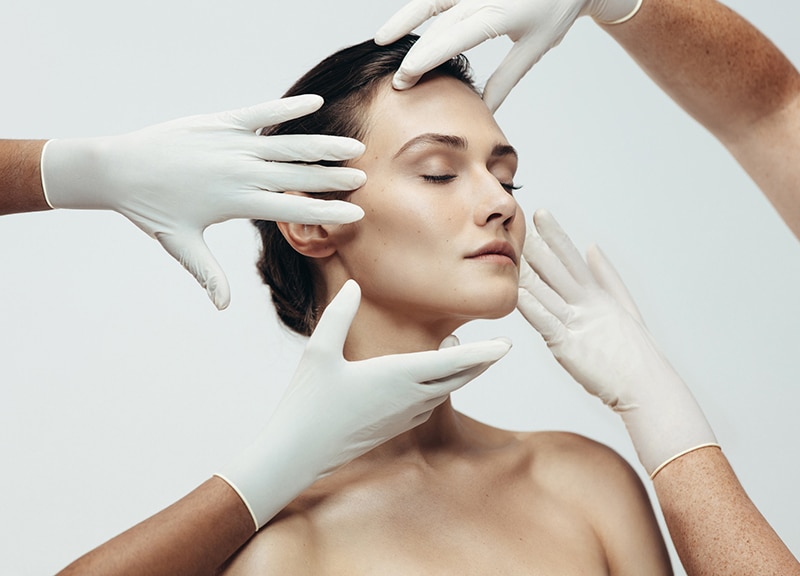
Educational Information
Get informed about cosmetic plastic surgery procedures and rejuvenating non-surgical treatments to help you make informed decisions about your desired treatment based on your aesthetic goals.
Testimonial and Practice Videos
Schedule a Consultation
Schedule a consultation with board-certified plastic surgeon, John Q. Cook, M.D., to learn more about plastic surgery solutions that may be right for you based on your aesthetic goals.
"*" indicates required fields
Our Office Locations
Our locations in the Gold Coast of Chicago and Winnetka in the North Shore reflect our commitment to convenient and discrete concierge-level service.
Chicago Office
737 North Michigan Ave., Suite 760 Chicago IL 60611 (312) 751-2112 Entrance at 151 E. Chicago Avenue
Winnetka Office
118 Green Bay Road Winnetka IL 60093 (847) 446-7562
Located directly across from Indian Hill Metra Station





